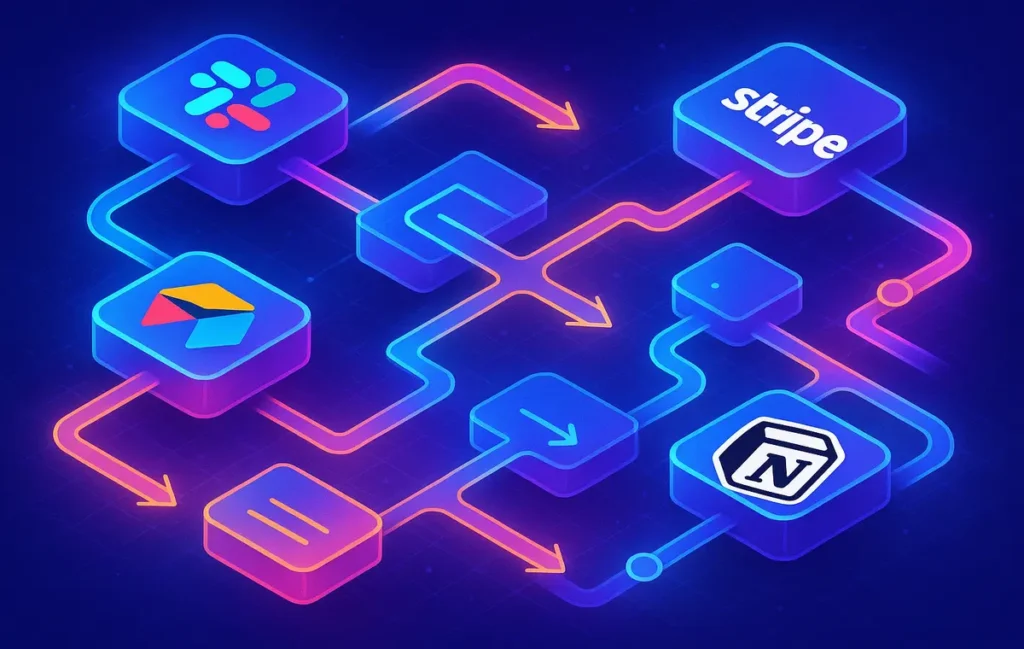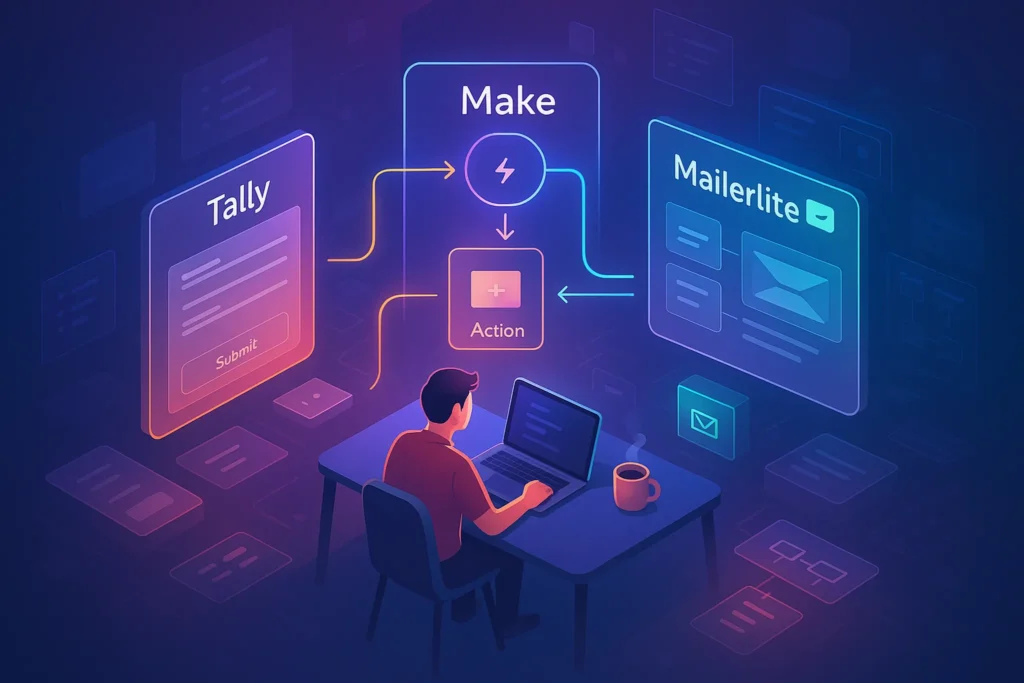🚀 Intro: Automation Beyond Developers
Not long ago, workflow automation was locked behind code. Developers wrote scripts, connected APIs, and maintained fragile systems that few outside of IT understood. In 2025, that barrier has crumbled. A new generation of no-code workflow builders has put automation power directly into the hands of solopreneurs, creators, marketers, and small teams.
Instead of weeks of development, workflows that integrate CRMs, social media, AI tools, and cloud apps now take a single afternoon. This is more than convenience—it’s a fundamental shift in how businesses scale. At NerdChips, we’ve seen how these tools move automation from “nice-to-have” to “critical advantage.” The future of digital productivity belongs not to those who code, but to those who can orchestrate systems quickly, visually, and flexibly.
🔍 What Are No-Code Workflow Builders?
A no-code workflow builder is a platform that lets you automate processes visually, without programming. You build flows by connecting triggers (“when this happens…”) to actions (“do this automatically…”). For example:
-
A new email in Gmail can auto-save attachments to Google Drive.
-
A sales lead submitted via Typeform can create a CRM entry, ping a Slack channel, and schedule a follow-up in Calendly.
-
A YouTube upload can trigger a blog draft, generate social posts, and update a Notion calendar.
These systems replace brittle scripts with drag-and-drop interfaces, templates, and integrations. The appeal is clear: instead of hiring developers for repetitive tasks, teams empower themselves to automate.
The distinction from coding-heavy solutions is speed and accessibility. A marketing team doesn’t need to know APIs to build automations anymore. SMBs and startups now run workflows once reserved for enterprises, which is why adoption has surged. (Our beginner’s guide on Workflow Automation 101 breaks down this transformation in detail.)
🏆 The Big Players in 2025
The market has matured, but five platforms dominate the space:
Zapier remains the most recognized name. Its 7,000+ app library makes it the “default” option for SMBs. It’s reliable, polished, and backed by years of trust. Yet, its higher pricing tiers remain a pain point, especially for scaling startups.
Make (formerly Integromat) has grown into the favorite for visual builders. Its flowchart-style editor lets users “see” their workflows as connected nodes. This clarity is invaluable for complex automations. Make also offers competitive pricing compared to Zapier, though it comes with a slightly steeper learning curve.
n8n Cloud brings the open-source ethos to no-code. Known for its flexibility, it allows advanced customizations, self-hosting options, and greater control. The hosted Cloud version makes it accessible to teams who don’t want to manage infrastructure. For developers who still want no-code speed but need depth, n8n stands apart.
Airtable Automations continue to rise. Since many teams already organize data inside Airtable, having built-in automations that trigger from database events creates a seamless flow. For SMBs that rely heavily on Airtable, this cuts out the need for third-party connectors.
Glide is bridging a different gap—combining workflow automation with app-building. By 2025, Glide’s AI-powered features allow users to create mobile or web apps where automations are baked in. For teams wanting both apps and workflows, Glide feels like a two-in-one solution.
📊 Quick Comparison Table
| Platform | Strengths | Limitations | Best For |
|---|---|---|---|
| Zapier | Largest app library, reliable | Expensive at scale | SMBs needing coverage |
| Make | Visual builder, flexibility | Steeper learning curve | Marketers, ops teams |
| n8n Cloud | Open-source flexibility | Setup can be complex | Tech-savvy teams |
| Airtable Autom. | Native to Airtable databases | Limited outside Airtable | Data-centric teams |
| Glide | App + automation combo | Narrower integrations | Creators, app builders |
📈 Emerging Trends in 2025
Three shifts define the year:
-
AI-assisted workflow building – Builders now recommend flows based on user activity. Some users report setup time reduced by up to 40% thanks to AI-generated suggestions.
-
Multi-platform orchestration – Instead of siloed automations, companies expect orchestration across finance, HR, sales, and marketing.
-
Open-source vs. proprietary battles – Teams must choose between freedom (n8n) and stability/support (Zapier).
-
SMB adoption curve – Surveys show 65% of SMBs in 2025 use at least one no-code workflow builder, double the rate from three years ago. See our guide on Best Workflow Automation Tools for Solopreneurs & Remote Teams for more insights.
⚖️ Pros & Cons of No-Code Workflow Builders
The advantages are obvious: speed, accessibility, and affordability. Automations once taking months now happen in hours. Founders save developer costs. Marketers scale campaigns instantly.
But pitfalls exist. Vendor lock-in can trap you in one ecosystem. Migrating a dozen workflows to another platform is time-consuming. Scalability is another risk. Many tools work beautifully for SMBs, but enterprises may hit execution or compliance ceilings. Finally, hidden costs often appear: certain integrations or volume limits require premium upgrades.
💡 Nerd Tip: Always check your tool’s scalability roadmap. Today’s perfect builder might hit a wall as your workflows or data volume grow.
💼 Use Cases in 2025
Marketing Automation – Lead forms triggering CRM updates, nurture emails, Slack notifications, and campaign reports.
Creator Workflows – Automating content repurposing. A TikTok upload can create a YouTube Short, schedule a Twitter snippet, and update a Notion content board. See our guide on Pro Tips for Automating Your Entire Content Workflow.
SMB Operations – Invoice generation, payroll alerts, HR onboarding sequences, and CRM sync. This replaces manual admin work. See Best No-Code Automation Tools for Small Business Owners.
Tech Creators – One user on X recently wrote: “Built a trading dashboard in a weekend with n8n + Airtable. Would’ve taken weeks of dev time. No-code = speed advantage.” Testimonials like this show how much velocity these tools add.
⚡ Automation for Everyone
Zapier, Make, n8n, Airtable, Glide—these aren’t just tools, they’re accelerators. Build workflows in hours and focus on growth, not grunt work.
🧩 Common Mistakes & Fixes
Many new users expect too much, too fast. The most common mistake is over-automating—building workflows for every small task. This creates fragility and confusion. Instead, start with high-value automations.
Another mistake is ignoring documentation. When a workflow fails silently, untested assumptions cost time and data. Testing and logging should always be part of the build.
Finally, teams underestimate hidden costs. A “$29/month” plan can balloon when premium connectors are added. Smart SMBs plan budgets with upgrade paths in mind.
🌍 Remote Work & Hybrid Benefits
No-code workflow builders shine in remote and hybrid setups. Distributed teams automate routine updates across Slack, Notion, Trello, and Google Workspace. This reduces async friction. A project manager in London can update Airtable, triggering instant updates in teammates’ tools across time zones.
For remote-first SMBs, automation replaces the “office manager” function, handling scheduling, reporting, and reminders. This lets lean teams scale like larger companies without extra hires.
🔮 The Future of No-Code Workflow Builders
The next frontier is blending no-code with AR/AI. Imagine designing workflows in 3D space using augmented reality, or AI assistants that auto-generate workflows based on observing your daily clicks.
Vendors are also working on eliminating platform boundaries. Soon, instead of Zapier for marketing and Airtable Automations for databases, orchestration layers may unify everything into a single workspace.
Enterprise adoption will also reshape the landscape. As compliance frameworks mature, we’ll see banks, hospitals, and governments using no-code automation at scale. The market is moving from convenience to infrastructure.
📬 Want More Automation Insights?
Join our free newsletter and get weekly strategies on workflow automation, AI tools, and no-code platforms—curated by NerdChips.
🔐 100% privacy. Only actionable, value-packed automation content from NerdChips.
🧠 Nerd Verdict
No-code workflow builders in 2025 are a paradox: they’re simultaneously liberating and limiting. They empower SMBs, solopreneurs, and creators with enterprise-grade automation, but they also raise risks of lock-in and scalability ceilings. The winners will be those who adopt intentionally, plan for growth, and stay flexible in tool choice. As automation moves mainstream, the smartest teams won’t ask “Can we build this?” but “Which no-code builder helps us build it fastest?”
❓ FAQ: Nerds Ask, We Answer
💬 Would You Bite?
If you had to start today, would you pick a simple visual builder like Make to move fast, or go all-in on open-source flexibility with n8n?
Crafted by NerdChips for creators, founders, and remote teams building smarter workflows without writing code.



